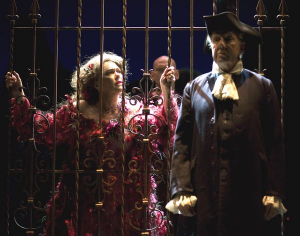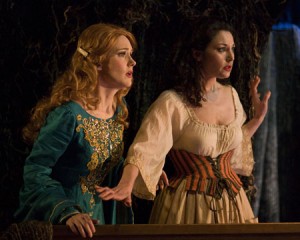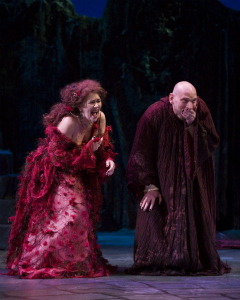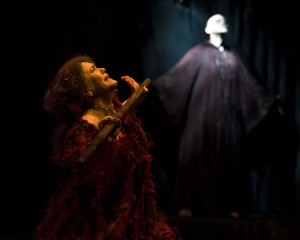COMIC EPHEMERA
In Tony Kushner’s adaptation of Pierre Corneille’s 1636 comedy L’Illusion Comique, the modern playwright has abandoned the contextual trappings that make the original at all interesting, in order to write for a contemporary audience. The result, in Casey Stangl’s fleet staging, very slightly disguises shallow earnestness as light amusement. It’s fun; it’s supposed to be fun; voila. What did you expect, a five-hour two-part examination of American repression and self-loathing from which only angels could reprieve us? Not this time.
 The story of a repentant father, Pridamant (the fine Nick Ullett), who consults the conjurer Alcandre (Deborah Strang) to seek news of the son he long ago disowned (Graham Hamilton), The Illusion reveals to Pridamant and to the playgoer just how ephemeral are our perceptions: of reality; of truth; of emotion. As the magician shows to her client an increasingly unlikely series of episodes in his son’s life, he begins slowly to appreciate the value of the things he has thrown away, and the worthlessness of some things he has treasured.
The story of a repentant father, Pridamant (the fine Nick Ullett), who consults the conjurer Alcandre (Deborah Strang) to seek news of the son he long ago disowned (Graham Hamilton), The Illusion reveals to Pridamant and to the playgoer just how ephemeral are our perceptions: of reality; of truth; of emotion. As the magician shows to her client an increasingly unlikely series of episodes in his son’s life, he begins slowly to appreciate the value of the things he has thrown away, and the worthlessness of some things he has treasured.
 The 17th Century version pointedly abandoned the theatrical sacrament of Aristotle’s Unities (of time, place and action), and mixed pastoral romance with tragic drama, and lampooned the Baroque tradition of multiple locations; but if such tweaks of the beard were a cause celebre then, they would be a cause for sleep now. Mr Kushner wisely attenuates the story and focuses on the disowned son and his various love affairs, all with characters played by the same two actresses (Devon Sorvari and Abby Craden). His foils (Alan Blumenfeld and Freddy Douglas) also wear many hats; even the magician’s footman (Jeff Doba) plays a part in the young man’s visionary journeys. Corneille’s convoluted theatrical joke is reduced here, but the play retains a metaphysical commentary that compels us toward the climax without destroying our faith in the proceedings, and ultimately pays off in the final scene.
The 17th Century version pointedly abandoned the theatrical sacrament of Aristotle’s Unities (of time, place and action), and mixed pastoral romance with tragic drama, and lampooned the Baroque tradition of multiple locations; but if such tweaks of the beard were a cause celebre then, they would be a cause for sleep now. Mr Kushner wisely attenuates the story and focuses on the disowned son and his various love affairs, all with characters played by the same two actresses (Devon Sorvari and Abby Craden). His foils (Alan Blumenfeld and Freddy Douglas) also wear many hats; even the magician’s footman (Jeff Doba) plays a part in the young man’s visionary journeys. Corneille’s convoluted theatrical joke is reduced here, but the play retains a metaphysical commentary that compels us toward the climax without destroying our faith in the proceedings, and ultimately pays off in the final scene.
 Some usual Noise Within gripes: the cast, while overall exactly right and wonderful (especially Ms Craden, Mr Blumenfeld and Mr Douglas), features a pair of ingenues who, while no doubt competent to portray modern lovers, here display neither the vocal nor physical training to persuasively embody period gesture or speech.
Some usual Noise Within gripes: the cast, while overall exactly right and wonderful (especially Ms Craden, Mr Blumenfeld and Mr Douglas), features a pair of ingenues who, while no doubt competent to portray modern lovers, here display neither the vocal nor physical training to persuasively embody period gesture or speech.
 And while Keith Mitchell has built a creepy and evocative background for these shenanigans, that giant thrust stage still forces him and Ms Stangl, as it has forced everyone working in this space to date, to perform an unwieldy dance in the all-important downstage playing area, where nearly all the action happens. In this case a wheeled gate must stand for many locations; to defend the use of a single set piece as theatrical economy would be, in this case, to overstretch a valid point. Must every show in a state-of-the-art facility suffer the same limitations? Some director or designer more used to the rare (in Southern California) thrust configuration, will one day figure out how to use this space to best effect; but at least the acoustics are better than they used to be, or the performers better schooled in the necessity to project when facing the back wall.
And while Keith Mitchell has built a creepy and evocative background for these shenanigans, that giant thrust stage still forces him and Ms Stangl, as it has forced everyone working in this space to date, to perform an unwieldy dance in the all-important downstage playing area, where nearly all the action happens. In this case a wheeled gate must stand for many locations; to defend the use of a single set piece as theatrical economy would be, in this case, to overstretch a valid point. Must every show in a state-of-the-art facility suffer the same limitations? Some director or designer more used to the rare (in Southern California) thrust configuration, will one day figure out how to use this space to best effect; but at least the acoustics are better than they used to be, or the performers better schooled in the necessity to project when facing the back wall.
 And this play, in its very playfulness, offers much to take our minds off any awkward staging. When Mr Douglas grins, when Ms Craden pouts, when Mr Blumenfeld blusters: we are transported, and the illusion before us comes happily into our selves. That it has largely evaporated by the time we start the car should not surprise us.
And this play, in its very playfulness, offers much to take our minds off any awkward staging. When Mr Douglas grins, when Ms Craden pouts, when Mr Blumenfeld blusters: we are transported, and the illusion before us comes happily into our selves. That it has largely evaporated by the time we start the car should not surprise us.
Photos by Craig Schwartz
The Illusion
A Noise Within in Pasadena (Los Angeles Theater)
scheduled to end on May 19, 2012.
for tickets, visit anoisewithin.org/boxoffice.html

